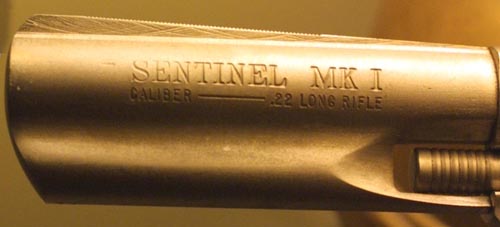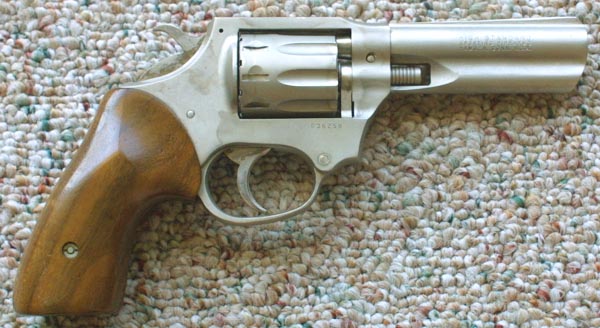 High Standard Sentinel MkI
High Standard Sentinel MkI
| Length Overall | Barrel Length | Weight | Caliber | Action Type | Capacity |
| 4 Inches | .22 L.R. | D.A. Revolver | 9 |
The Sentinel series began production in the early sixties, based upon an original design which began production in the mid fifties, and progressed through a series
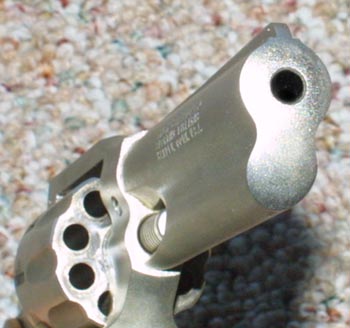 of models. The originals are well made, handy, good performing guns,
though they are a bit on the plain side. The quality of the metal, and
of the finish, as well as the tightness of the lock up are as good as anything
which carries the Colt, or Smith and Wesson logo. In 1974, High standard
made some design changes, and incorporated some cosmetic updates into
the venerable line, coming up with the Mark series. This updated design,
the MKI, was quite a good looking gun. It somewhat overshadowed the plain
Jane line from which it had descended. High Standard made no distinction
between the various models of it's revolver line, and marketed them as a
single series. The following MKII, and MKIII guns were completely different
from the MKI, being a fixed barrel version of the Dan Wesson. The next
gun in the old Sentinel series was the MKIV, which was essentially a MKI
chambered for the 22WMRF.
of models. The originals are well made, handy, good performing guns,
though they are a bit on the plain side. The quality of the metal, and
of the finish, as well as the tightness of the lock up are as good as anything
which carries the Colt, or Smith and Wesson logo. In 1974, High standard
made some design changes, and incorporated some cosmetic updates into
the venerable line, coming up with the Mark series. This updated design,
the MKI, was quite a good looking gun. It somewhat overshadowed the plain
Jane line from which it had descended. High Standard made no distinction
between the various models of it's revolver line, and marketed them as a
single series. The following MKII, and MKIII guns were completely different
from the MKI, being a fixed barrel version of the Dan Wesson. The next
gun in the old Sentinel series was the MKIV, which was essentially a MKI
chambered for the 22WMRF.The MKI went out of production in 1976, after a production run of only two years. By the time I turned 21 there were, alas, no MKI models to be found, the gun having been out of production for several years. The MKIV went out of production the same year, except for two offerings; but I did not really want a 22 Magnum. In 1984, High Standard ceased production, and though the company was to be brought back to life years latter, to reestablish production of the Citation series of semi auto pistols, never again would the company produce a revolver. The company presently produces, in addition to it's line of rimfire semi automatics, a line of 1911 style pistols, the AMT Automag series, and a selection of AR-15 rifles.
The frame of the Sentinel MKI is of a size similar to that of the S&W J frame. This makes this light handy little gun, a natural for a companion piece out in the field. The compact size, along with the simple construction, and the nickel finish on this particular piece, make it suitable for use as a knock
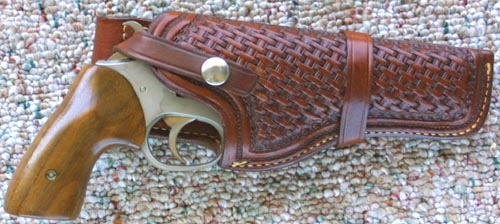 around gun. The four inch barrel allows for good accuracy, and easy
aiming. As with most field or duty revolvers, the sights on this gun are
of the fixed type, basically a notch milled into the top of the frame.
Fixed sights do not offer the versatility of the adjustable types; but are
probably a much better choice for this type of gun, and for the type of
life that it will probably lead. The front sight is a long ramp, which is
unlikely to catch or snag on anything. This is a great gun to take out in
the woods as a plinker, and will probably be my companion gun out in the
field, for boating, and to enhance my other outdoor activities. This gun
was bought used, and came with a reasonably nice field holster.
around gun. The four inch barrel allows for good accuracy, and easy
aiming. As with most field or duty revolvers, the sights on this gun are
of the fixed type, basically a notch milled into the top of the frame.
Fixed sights do not offer the versatility of the adjustable types; but are
probably a much better choice for this type of gun, and for the type of
life that it will probably lead. The front sight is a long ramp, which is
unlikely to catch or snag on anything. This is a great gun to take out in
the woods as a plinker, and will probably be my companion gun out in the
field, for boating, and to enhance my other outdoor activities. This gun
was bought used, and came with a reasonably nice field holster. This particular example sports the satin nickel finish, and is quite an attractive gun. It has fixed sites, and a 4" barrel. It's handy size, and nickel finish assure that it will be my field gun, kit gun, and all around plinker. The action is remarkably tight. With the trigger back, there is absolutely no play in the cylinder at all. Remarkable! My Dan Wesson, as much as I hold it in high regard, is not as tight. There is some mottling on my Sentinel, either from having been improperly cleaned, or simply from over three decades use out in the world. This does not particularly bother me, and in no way affects the functioning of the gun. Still, if I can find a way to fix this, it will probably be done.
These guns lock the cylinder at the rear, using the ejector lever as a latch. Giving the lever a pull forward will release the cylinder for loading. Giving it a push will
Teh gun is nicely finished, and nicely machined. As in the pre 1981 S$W revolvers, the cylinder chambers are counterbored, and recessed. This may not have any practical purpose, particularly with the low pressures at which the 22 Long Rifle cartridge operates; but it is a nioce feature, and lends the gun just a bit of class. This is particularly true when taken in concert with all fo teh other nice vanity features fo the Sentinel MkII, such as the raduised barrel, and the full length ejector shroud. When S&W stopped recessing the chambers of their revolvers, many firearms enthusiasts mourned the loss of this feature, so much that these guns can command a premium in the marketplace. This certainly an effect on the value fo the little Sentinel. These guns are selling for nearly as much as one of the old field grade S&W revolvers. I recall being in a gun shop a year or so ago, and seeing a S&W M-28 going for about the same price as a Sentinel MKII.
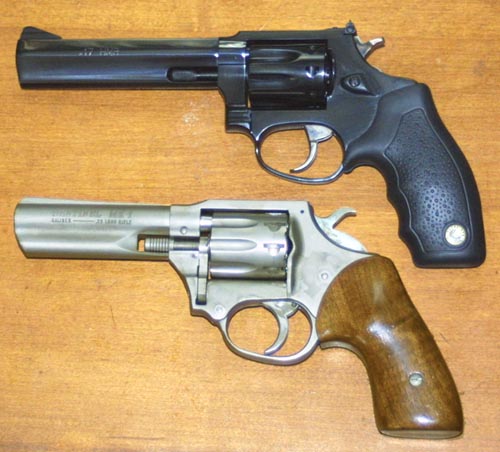 The Sentinel seems to beg for comparison with my
Taurus 17 caliber, even though they fire different cartridges. Both guns
are of a similar size, fire rimfire cartridges, and are more or less designed
to fill a similar role. The also share the radiused muzzle, and fully shrouded
barrel. Both guns are fun to shoot, handy to carry, and rather good looking,
The Sentinel has a slightly non standard cylinder crane. The crane is a
lever set in front of the cylinder, and behind the front section of the
frame, rather than the more common split frame construction of the Taurus,
S&W, and most other revolver types. This detracts a bit from the flowing
lines of the gun; but may actually increase the strength of the frame. Though
these rimfire pistols are not really designed for hunting or for defense,
they will certainly fill this role, if the shooter performs properly.
The Sentinel seems to beg for comparison with my
Taurus 17 caliber, even though they fire different cartridges. Both guns
are of a similar size, fire rimfire cartridges, and are more or less designed
to fill a similar role. The also share the radiused muzzle, and fully shrouded
barrel. Both guns are fun to shoot, handy to carry, and rather good looking,
The Sentinel has a slightly non standard cylinder crane. The crane is a
lever set in front of the cylinder, and behind the front section of the
frame, rather than the more common split frame construction of the Taurus,
S&W, and most other revolver types. This detracts a bit from the flowing
lines of the gun; but may actually increase the strength of the frame. Though
these rimfire pistols are not really designed for hunting or for defense,
they will certainly fill this role, if the shooter performs properly.The Sentinel is a bit more of a field gun than my previous field revolver, the Dan Wesson, and seems destined to be mated to my Henry .22, or my Ruger 10/22, as part of a rimfire pistol/carbine combo. I have a great enthusiasm for pairing off longarms with pistols which fire the same round. The Dan Wesson will remain my target .22, along with the Browning Buck Mark. I am now beginning to acquire quite the rimfire arsenal.
Grips are smooth walnut, and are quite compact. The wood is of fair quality, and imperfectly matched; but decent looking, There is no flare at the bottom of the grip, as there generally is with so called target grips, making the Sentinel grips comfortable, and making the gun a fairly natural pointer. They are of the traditional two piece construction, and are held to the butt of the revolver with a single screw.
Being of a size similar to that of the S&W J frame, the Sentinel is quite a slim and light package compared to the standard police issue K frame revolvers. I have included a photo of the similarly colored S&W model 65 medium frame K frame revolver in 357 Magnum, for comparison.
 In a pinch, the smaller gun, even with it's four inch barrel, is reasonably
concealable. Though not quite up to the durability and corrosion resistance
of the stainless gun, the nickel finish of the little Sentinel does creditable
service against the elements. Niether gun is a worrisome companion out
in the field, and though the 357 magnum model 65 is by far the more lethal
member of the pair, the 22 Sentinel is quite a bit more fun. Having nine
rounds on tap rather than the six of the Smith, adds to the smaller gun's
appeal.
In a pinch, the smaller gun, even with it's four inch barrel, is reasonably
concealable. Though not quite up to the durability and corrosion resistance
of the stainless gun, the nickel finish of the little Sentinel does creditable
service against the elements. Niether gun is a worrisome companion out
in the field, and though the 357 magnum model 65 is by far the more lethal
member of the pair, the 22 Sentinel is quite a bit more fun. Having nine
rounds on tap rather than the six of the Smith, adds to the smaller gun's
appeal.Being out of production for several decades, makes finding accessories for the little Sentinel a bit of a chore. I am still looking for a quartet of speed loaders, as well as a set of slim rubber grips. Holsters are easy enough to find, as they are a number of similarly sized revolvers; but I will probably stick with the field holster that came with the gun. Parts may be a problem, if the gun should ever require service; but this seems a minor concern, considering the quality of construction, and the minimal demands of the 22 long rifle cartridges that it fires.
So at last I have it, and I must admit that I am not disappointed. Overall I like the Sentinel quite a bit. High Standard should consider putting these little guns back into production again. Though I have many guns which are more powerful, more accurate, and better made, somewhere deep inside of me lurks a very satisfied sixteen year old, who is very happy and excited over the new purchase. This boy had a great time at the range, plastered a big smile on my face, and greatly looks forward to taking the Sentinel out in the woods, and blasting tin cans. Like most men, I have a hard time saying no, and often indulge the sixteen year old boy who disappeared when I grew up.
The High Standard Sentinel series.
| Model |
Caliber |
Barrel lengths |
Capacity |
Features |
| Sentinel |
.22 L.R. |
3",4",5",6" |
9 |
The original small frame revolver. |
| MKI |
.22 L.R. |
2",3",4" |
9 |
This is the Sentinel with a shrouded barrel,
a radiused muzzle, and a reshaped frame. |
| MKII |
357 Mag |
2.5",4",6" |
9 |
This is essentially the Dan Wesson revolver,
without the interchangeable barrel |
| MKIII |
357 Mag. |
2.5",4",6" |
6 |
This is the MKII with adjustable sights |
| MKIV |
.22 WMRF |
2",3",4" |
9 |
This is a MKI in .22 Magnum. |
| Camp Gun |
.22 L.R.,22 WMRF |
6" |
9 |
This is the 22 Sentinel with a 6" barrel. |
